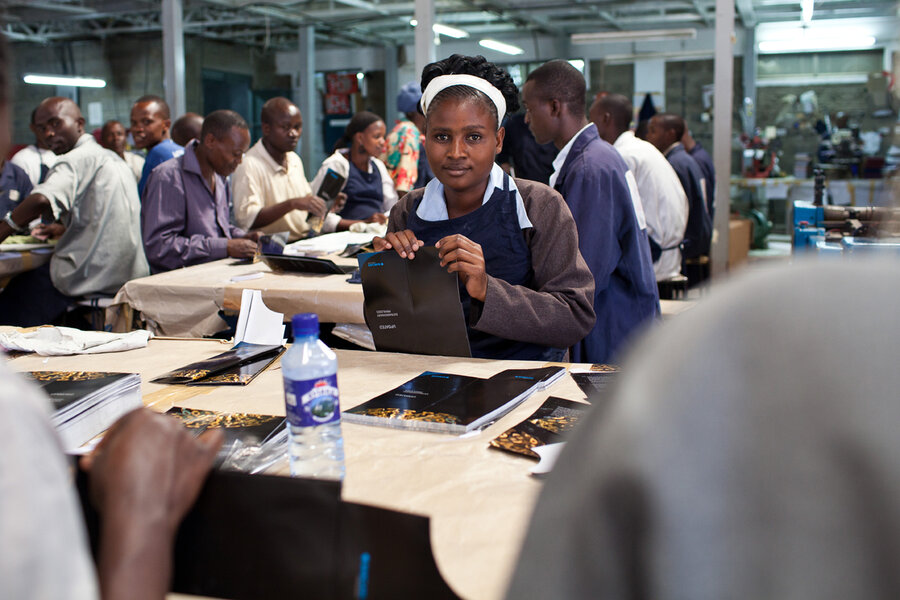Nairobi's manufacturing center showing signs of growth once again
Loading...
| Nairobi, Kenya
This post is part of the Daily Dispatch project chronicling life in Nairobi, Kenya throughout the month of April.
With an incessant computer-controlled hiss clack clack, hiss clack clack, a million-dollar machine the size of a bus was churning out 14,000 bank flyers an hour.
Over in the corner, sales pouches for a cellphone firm’s SIM cards were being folded. Nearby, neat stacks of "An Introduction to Public Health" stood ready for shipping.
This 44-year-old firm, Colourprint, housed in a nondescript factory off a potholed road, is one of hundreds of companies clustered in Nairobi’s industrial area.
These 20-odd square miles southeast of the city center help power Kenya’s $2 billion-a-year manufacturing sector, the second-strongest driver of economic growth.
That growth peaked at 7.1 percent in 2007, before the global economic crisis and Kenya’s post-election turmoil knocked it down to 1.7 percent. Today, it’s rising again, with the government boasting of expected 5 percent expansion this year.
Like many Nairobi-based businesspeople, Colourprint’s chairman, Bushan Vidyarthi, is optimistic for the future.
“This is going to be a great country,” he said, touring Daily Dispatches around the factory floor as technicians finalized print plates and workers glued and folded finished jobs.
“Kenya is a hub, and Nairobi’s in the middle of it. Industry is highly developed, engineering, manufacturing, services, all of it. Airline connections are great, the roads will be great when they finish them. You have unlimited scope for business.”
Vidyarthi’s realistic as well, however. “Things have changed a lot in the last five years,” he said. “But there is still too much red tape, we still have to pay 25 percent import duty on raw materials, and our electricity bills have tripled in three years.”
Under its much-flaunted Vision 2030 program, the government in Nairobi has laid out ambitious plans to bring Kenya from a ‘low-income’ country to a ‘middle-income’ one in 19 years time.
Making it easier and cheaper to do business here in Kenya’s capital is a key plank in that mission, as is encouraging even more international investors to come here.
Already, there are good signs. Nestlé last month announced $30 million plans to boost its Nairobi-based production eightfold in the next five years. Unilever is ploughing in $38 million to increase business. Pepsi-Cola said in March it is returning with a $30 million new plant, after 40 years away from the Kenyan market.
Each of these mammoth multinationals has been drawn to Nairobi because of its existing market, its infrastructure and its relative stability.
But the single biggest pull was the launch last year, finally, of the East African Community, connecting Kenya, Tanzania, Uganda, Rwanda and Burundi in a single duty-free economic zone.
That gives businessmen like Vidyarthi a market of something upwards of 130 million people, compared to the 39 million in Kenya alone.
Across the industrial area, Ashu Sennik is more circumspect. He runs Desbro Engineering, a stainless steel firm making tanks, pipes and fittings for companies including Nairobi’s fledgling microbreweries.
“There’s still too much red tape at the East African Community, it’s going through some serious teething troubles,” he said.
Kenya’s election-time political instability is also a concern, he says, as it drives dangerous fluctuations in the foreign exchange rates. The US dollar is currently trading at 85 Kenya shillings to $1. In 2008, it was 69 shillings to the dollar.
“But things are changing,” he said. “We’re getting more and more competitive, we have a well-educated young workforce who are ready to learn, and clients’ demands for more value for money is refining the business landscape.
“The opportunities are there, and we’re in the right place, that’s for certain.”





